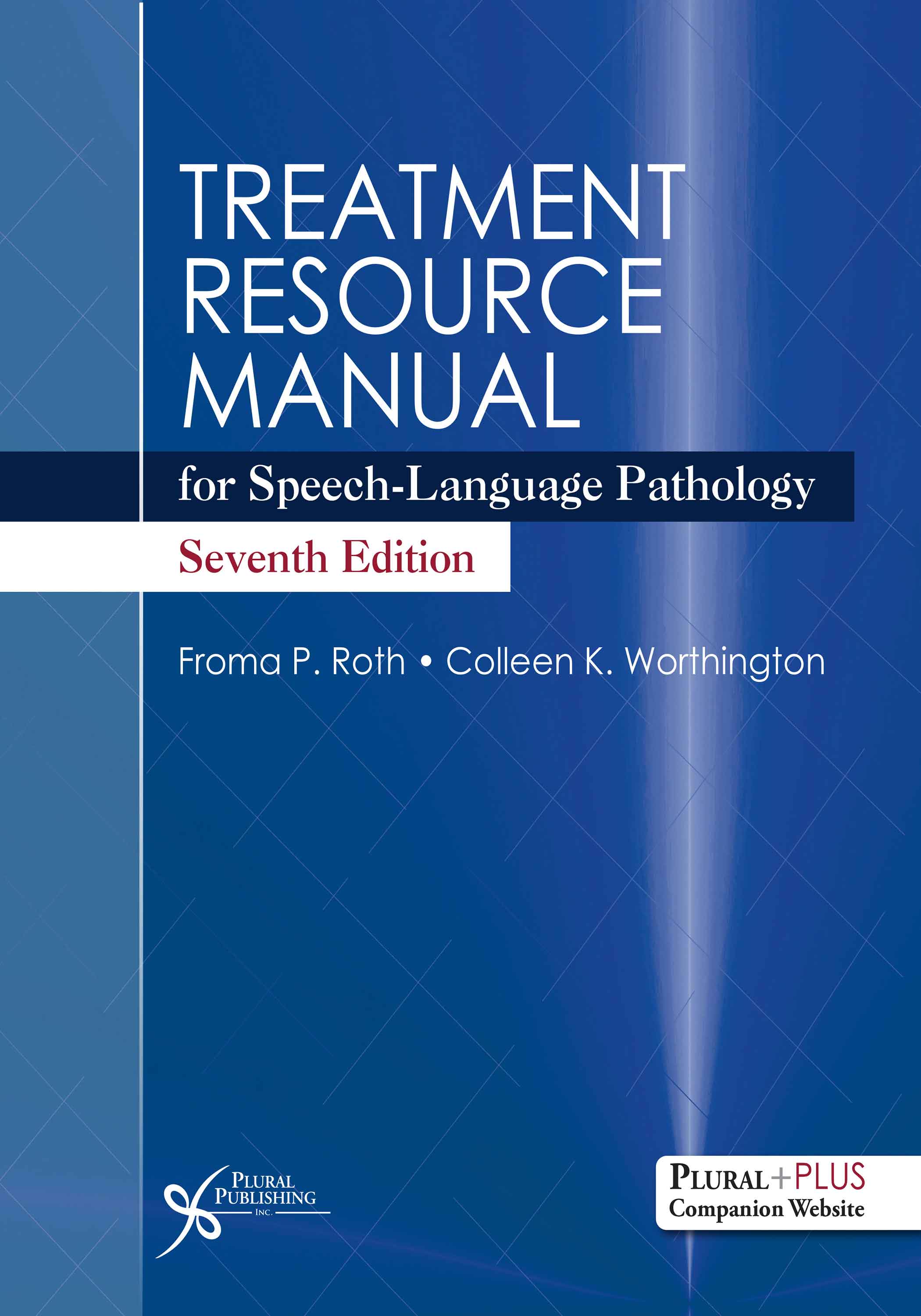
Treatment Resource Manual for Speech-Language Pathology
Seventh Edition
Froma P. Roth, Colleen K. Worthington
Details: 447 pages, Two-Color, Softcover, 8.5" x 11"
ISBN13: 978-1-63550-653-2
© 2025 | Available
For Instructors
Purchase
The leading book on intervention methods in speech-language pathology!
Now with more online supplementary materials!
With major content updates and many more supporting online materials, the seventh edition of the Treatment Resource Manual for Speech-Language Pathology is an accessible and reliable source of basic treatment information and techniques for a wide range of speech and language disorders. This detailed, evidence-based manual includes complete coverage of common disorder characteristics, treatment approaches, reporting techniques, and patient profiles for child and adult clients.
Divided into two sections, the first focuses on preparing for effective interventions, and includes the basic principles of speech-language therapies including various reporting systems and techniques. The second part, the bulk of the book, is devoted to treatments for specific communication disorders, including speech sound disorders, pediatric language disorders, autism spectrum disorder, adult aphasia and traumatic brain injury (TBI), motor speech disorders, dysphagia, stuttering, voice disorders, and alaryngeal speech. The last three chapters focus on effective counseling skills, cultural competence and considerations, and contemporary professional issues, including critical thinking, telepractice, simulation technologies, and coding and reimbursement.
Treatment Resource Manual for Speech-Language Pathology, Seventh Edition is an ideal resource for academic courses on intervention and clinical methods in graduate speech-language programs and as a more practical supplementary text to the more traditional theoretical books used for undergraduate clinical methods courses. It is also helpful as a study guide for certification and licensing exams, and a handy manual for practicing clinicians in need of a single resource for specific therapy techniques and materials for a wide variety of communication disorders.
New to the Seventh Edition
- Updates to each disorder-focused chapter on treatment efficacy and evidence-based practice
- New focus on a social model of disability (diversity-affirming approach to intervention)
- Substantial update on approaches for autism
- Expanded discussion of the use of telepractice to conduct intervention
- Expanded information on cultural/linguistic diversity and cultural responsiveness/competence within the context of therapeutic intervention
- Updated information on incidence/prevalence of aphasia and expanded discussion of treatment efficacy in TBI, spasmodic dysphonia, and goals for treatment of motor speech disorders
- QR codes in the margins lead to websites of the key resources discussed
- Additional Helpful Hints in each disorder chapter
- Updates to the Lists of Additional Resources and Recommended Readings
- Updated citations and references throughout
- Significant expansion of supplementary online materials to facilitate pedagogy and enhance learning
Key Features
- Chapters focused on treatment of disorders include a concise description of the disorder, case examples, specific suggestions for the selection of therapy targets, and sample therapy activities
- QR codes linking to key resources
- Bolded key terms with an end-of-book glossary
- A multitude of case examples, reference tables, charts, figures, and reproducible forms
- Helpful Hints and Lists of Additional Resources in each chapter
- Updated book appendices that include the new ASHA Code of Ethics and Cultural Competency checklists in addition to disorder-specific appendices in many chapters
PluralPlus Online Ancillary Materials
For instructors: PowerPoint slides, Test bank, In-Class Activities, Videos
For students and clinicians: Study quizzes, Glossary, Flashcards, Videos, Printable forms/documents, Appendices, and Bibliography
Case Examples by Disorder
List of Tables
List of Forms and Figures
Preface
Acknowledgments
About the Authors
Part One. Preparing for Effective Intervention
Chapter 1. The Essential Ingredients of Good Therapy: Basic Skills
Philosophy
Universal Design Principles for Learning: An Overarching Framework
General Principles of Intervention
Programming
Selection of Therapy Targets
Sequencing of Therapy Targets
Generalization/Carryover
Termination of Therapy
Formulation of Behavioral Objectives
Theories of Learning
Innateness Theory/Biological Model
Behavioral Model
Constructivism/Interactionist/Integrative Model
Behavior Modification
Types of Reinforcement
Positive Behavioral Interventions and Supports
Schedules of Reinforcement
Key Teaching/Scaffolding Strategies
Homework
Session Design
Basic Training Protocol
Task Order
Dynamics of Therapy
Group Therapy
Data Collection
Recording Session Data
Probes
Collaborative Service Delivery Models
Multitiered Systems of Support/Response to Intervention
Current Challenges of RTI
Treatment Efficacy/Evidence-Based Practice
Treatment Intensity and Dosage
Setting Specific Professional Terminology
Troubleshooting Tips for Therapy Sessions
Conclusion
Additional Resources
Chapter Appendices located on the PluralPlus companion website (not included in print version)
Appendix 1–A: Therapy Observation Checklist
Appendix 1–B: Worksheet for Identifying Behavioral Objectives
Appendix 1–C: Worksheet for Formulating and Writing Behavioral Objectives
Appendix 1–D: Sample Daily Therapy Plan
Appendix 1–E: Daily Therapy Plan
Appendix 1–F: Report of Observation Hours
Appendix 1–G: Instructions for Using Data Recording Forms
Appendix 1–H: Sample Positive Behavioral Intervention and Support Plan
Chapter 2. Information Reporting Systems and Techniques
Philosophy
Technical Writing Style
Report Formats
Initial Therapy Plan
Session Notes
Progress and Final Reports
Tips for Proofreading Clinical Reports
Individualized Education Program
Due Process
Individualized Family Service Plan
504 Plan
Professional Correspondence
Health Insurance Portability and Accountability Act
Additional Resources
Chapter Appendices located on the Plural+Plus companion website (not included in print version)
Appendix 2–A: Sample Initial Therapy Plan
Appendix 2–B: Sample Progress Report
Appendix 2–C: Health Insurance Portability and Accountability Act (HIPAA)
Part Two. Providing Treatment for Communication Disorders
Chapter 3. Intervention for Articulation and Phonology in Children
Treatment Approaches
Traditional
Motor-Kinesthetic
Distinctive Features
Paired Oppositions—Minimal and Maximal
Phonological Processes
Cycles Approach
Core Vocabulary
Metaphon
Oral-Motor Considerations
Treatment Efficacy and Evidence-Based Practice
Target Selection for Intervention Programming
Developmental
Nondevelopmental
Helpful Hints (Functional Articulation Disorders)
Helpful Hints (Phonological Disorders)
Organic Articulation Disorders
Cleft Palate
Example Profile
Sample Activities
Helpful Hints
Hearing Impairment
Example Profile
Sample Activities
Helpful Hints
Childhood Apraxia of Speech
Example Profile
Sample Activities
Helpful Hints
Conclusion
Articulation and Phonology
Oral-Motor Dysfunction
Additional Resources
Articulation
Phonology
Chapter Appendices located on the Plural+Plus companion website (not included in print version)
Appendix 3–A: Phonetic Placement Instructions for Difficult-to-Teach Sounds
Appendix 3–B: Diadochokinetic Rates for Children
Introduction to Chapters 4 and 5. Introduction to Language Intervention for Children and Adolescents
Classification of Language Disorders
Relationship Between Oral Language and Literacy
Role of the Speech-Language Pathologist in Literacy
Theoretical Models of Intervention
Treatment Efficacy/Evidence-Based Practice
Chapter 4. Intervention for Language in Infants and Preschool Children
Intervention With Infants (Birth to 3 Years)
American Speech-Language-Hearing Association (ASHA) Early Intervention Guidelines
Prelinguistic and Early Language Therapy Targets
Helpful Hints
Intervention With Children (3 to 5 Years)
Treatment Approaches for Infants, Toddlers, and Preschoolers
Emergent Literacy Intervention (Birth Through Preschool Years)
Helpful Hints
Conclusion
Additional Resources
Chapter Appendices located on the Plural+Plus companion website (not included in print version)
Appendix 4–A: Developmental Language Milestones: Birth to 5 Years
Appendix 4–B: Gross and Fine Motor Developmental Milestones
Appendix 4–C: Stages of Cognitive Development
Appendix 4–D: Gesture Developmental Milestones: 9 to 16 Months
Appendix 4–E: Development of Vision
Appendix 4–F: Feeding Developmental Milestones
Appendix 4–G: Stages of Play Development
Appendix 4–H: Developmental Toy List
Appendix 4–I: Examples of Lessons From “Promoting Awareness of Speech Sounds” (PASS)
Chapter 5. Intervention for Language in School-Age Children Through Adolescence
Characteristics of Students Ages 5 to 10 Years
Characteristics of Adolescents 10 to 18 Years
Intervention Considerations for School-Age Children and Adolescents
The Common Core State Standards
Treatment Approaches for School-Age Children and Adolescents
Instructional Strategies for Writing
Example Profiles
Conclusion
Additional Resources
Chapter Appendix located on the Plural+Plus companion website (not included in print version)
Appendix 5–A: Types of Cohesion
Chapter 6. Intervention for Autism Spectrum Disorder (ASD)
Overview of Autism Spectrum Disorder
Incidence
Etiology
Characteristics of Children With ASD
Social Communication
Repetitive/Restricted Behaviors, Interests, and Activities
Language and Speech Considerations
Emergent Literacy and Literacy
Medications
Outcomes
Treatment Efficacy/Evidence-Based Practice
Treatment for Autism
Theoretical Models
Treatment Approaches
Helpful Hints
Conclusion
Additional Resources
Chapter 7. Intervention for Adult Aphasia With Introduction to Traumatic Brain Injury
Aphasia
Classification of Aphasia Syndromes
Treatment Efficacy/Evidence-Based Practice
Treatment for Aphasia
Neuroplasticity
Theoretical Orientations to Aphasia Treatment
Guidelines for Programming and Implementing Therapy
Specific Intervention Procedures
Helpful Hints
Conclusion
Additional Resources
Traumatic Brain Injury (Coauthored by Emily DeAngelis)
Communication
Executive Functioning
Attention and Memory
Behavior
Treatment Efficacy/Evidence-Based Practice
Treatment for Traumatic Brain Injury
Helpful Hints
Conclusion
Additional Resources
Chapter Appendices located on the Plural+Plus companion website (not included in print version)
Appendix 7–A: Suggestions for Enhancing Verbal Interaction With a Family Member With Aphasia
Appendix 7–B: Guidelines for Conversational Coaching
Chapter 8. Intervention for Motor-Speech Disorders: The Dysarthrias, Apraxia of Speech, and Dysphagia
Treatment for Motor-Speech Disorders
The Dysarthrias
Treatment Efficacy/Evidence-Based Practice
Treatment for the Dysarthrias
Apraxia of Speech
Treatment Efficacy/Evidence-Based Practice
Treatment for Apraxia of Speech
Helpful Hints
Conclusion
Additional Resources
Dysphagia
Treatment for Dysphagia
Helpful Hints
Conclusion
Additional Resources
Chapter 9. Intervention for Stuttering
Categories of Stuttering Behaviors
Core Behaviors
Secondary Behaviors
Developmental Disfluencies Versus Stuttering
Treatment for Fluency Disorders
Treatment Efficacy/Evidence-Based Practice
Intervention Techniques
Helpful Hints
Helpful Hints
Conclusion
Additional Resources
Chapter Appendix located on the Plural+Plus companion website (not included in print version)
Appendix 9–A: Sample Phrases, Questions, and Monologues
Chapter 10. Intervention for Voice and Alaryngeal Speech
Voice Disorders
Classification of Voice Disorders
Treatment Efficacy/Evidence-Based Practice
Treatment for Voice Disorders
Intervention Techniques
Transgender Voice
Helpful Hints
Alaryngeal Speech
Treatment for Alaryngeal Clients
Mechanical Devices
Esophageal Speech
Tracheoesophageal (TEP) Speech
Helpful Hints
Conclusion
Additional Resources
Chapter Appendix located on the Plural+Plus companion website (not included in print version)
Appendix 10–A: Additional Dialogue Scripts for Voice Therapy Activities
Chapter 11. Client and Family Counseling
Five Key Traits of an Effective Counselor
Stages of Counseling
Establishing the Therapeutic Relationship
Implementing Counseling Intervention
Terminating the Therapeutic Relationship
Client and Family Emotional Reactions to Communicative Disorders
Counseling Techniques for Communicative Disorders
Group Counseling
Family Systems Counseling
Helpful Hints
Conclusion
Additional Resources
Chapter 12. Multicultural Issues in Intervention/Diversity, Equity, Inclusion, and Accessibility (DEIA)
Cultural Competence
Cultural/Ethnic Background
Socioeconomic Status (SES)
Linguistic Differences
Clinical Considerations for Children
Terminology
Patterns of Second-Language Acquisition
Educational Models
Clinical Considerations for Adult Populations
Clinical Considerations for Multilingual Populations With Language Disorders
Helpful Hints
Conclusion
Additional Resources
Chapter 13. Contemporary Issues
Critical Thinking
Components of Critical Thinking
Strategies/Techniques for Promoting Critical Thinking
Telepractice
Evidence Base for Telepractice
Privacy and Regulatory Issues
Basic Clinician Competencies With Technology
Candidates for Telepractice Services
Simulation Technologies
Standardized Patients (SPs)
Computer-Based Learning Experiences (CBLEs)
Implementation
Coding and Reimbursement
CPT Codes
ICD-10 Codes
Documentation
Helpful Hints
Conclusion
Whole-Book Appendices located on the Plural+Plus companion website (not included in print version)
Appendix A: ASHA Code of Ethics
Appendix B: International Phonetic Alphabet Symbols
Appendix C: Glossary of Selected Medical Terms
Appendix D: Schematic of the Vocal Tract
Appendix E: Cultural Competency Check-Ins
References
Index
Treatment Resource Manual for Speech-Language Pathology, Seventh Edition comes with access to supplementary student and instructor resources on a PluralPlus companion website.
The companion website is located at: https://www.pluralpublishing.com/publication/trmslp7e
STUDENTS:
The student resources include Glossary eFlashcards, Videos, Printable Forms, Appendices, and Bibliography.
To access the resources, you must register on the companion website and log in using the access code located in the front of your textbook. If you purchased an eBook directly from Plural accessible on the Plural eReader, the resources are accessible within the Plural eBook.
INSTRUCTORS:
The instructor resources include PowerPoint Lecture Slides, Test Bank, Videos, and In-Class Activities. You will also have access to the student resources listed above.
To access the instructor materials, you must contact Plural Publishing, Inc. to be verified as an instructor and receive your access code.
Email: instructormaterials@pluralpublishing.com
Tel: 866-758-7251 (toll free) or 858-492-1555

The Auditory System: Anatomy, Physiology, and Clinical Correlates
Second Edition
Frank E. Musiek, Jane A. Baran
Details: 487 pages, Full Color, Hardcover, 8.5" x 11"
ISBN13: 978-1-94488-300-3
© 2020 | Available
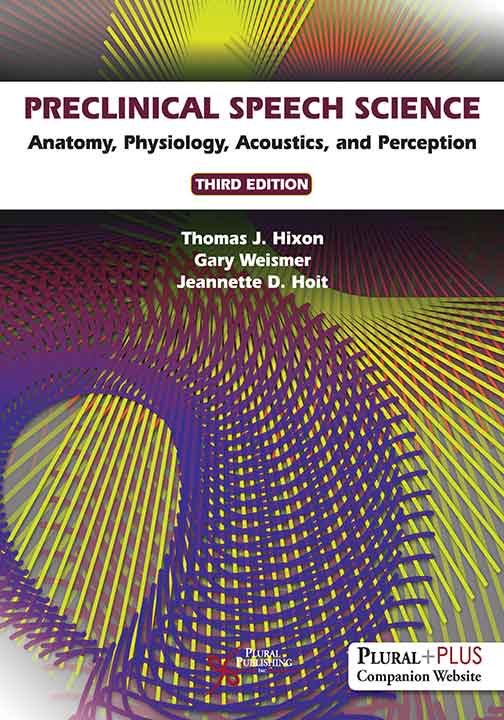
Preclinical Speech Science: Anatomy, Physiology, Acoustics, and Perception
Third Edition
Thomas J. Hixon, Gary Weismer, Jeannette D. Hoit
Details: 728 pages, Full Color, Hardcover, 8.5" x 11"
ISBN13: 978-1-63550-061-5
© 2020 | Available
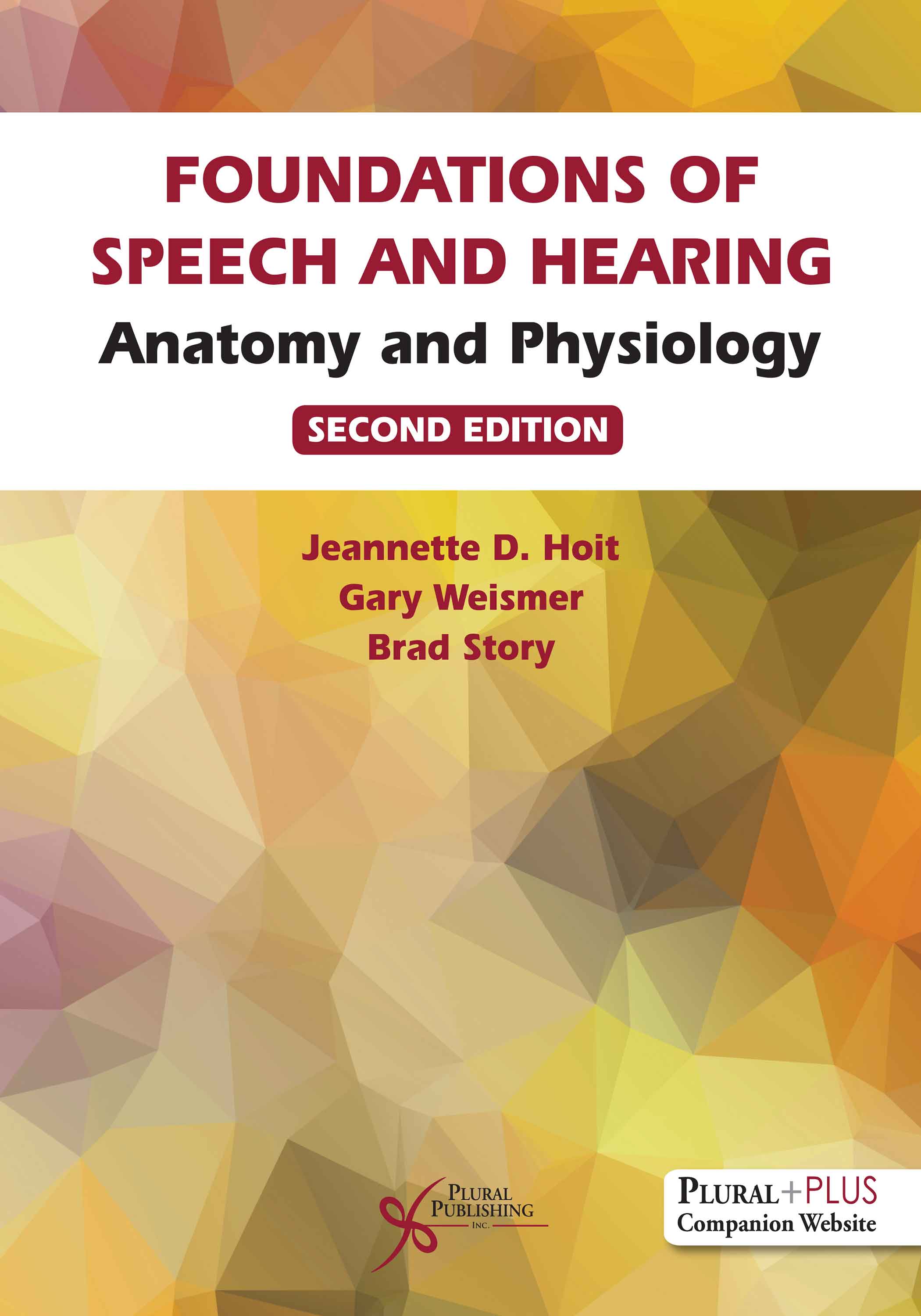
Foundations of Speech and Hearing: Anatomy and Physiology
Second Edition
Jeannette D. Hoit, Gary Weismer, Brad Story
Details: 348 pages, Full Color, Hardcover, 8.5" x 11"
ISBN13: 978-1-63550-306-7
© 2022 | Available

Fundamentals of Anatomy and Physiology of Speech, Language, and Hearing
First Edition
Glen M. Tellis, M. Hunter Manasco
Details: 478 pages, Full Color, Hardcover, 8.5" x 11"
ISBN13: 978-1-63550-720-1
© 2025 | Available

Assessment in Speech-Language Pathology: A Resource Manual
Seventh Edition
Kenneth G. Shipley, Julie G. McAfee
Details: 660 pages, Full Color, Softcover with layflat binding, 8.5" x 11"
ISBN13: 978-1-63550-710-2
© 2025 | Available

Goal Setting in Speech-Language Pathology: A Guide to Clinical Reasoning
First Edition
Casey Taliancich-Klinger, Angela J. Kennedy, Catherine Torrington Eaton
Details: 114 pages, B&W, Softcover, 6" x 9"
ISBN13: 978-1-63550-432-3
© 2025 | Available
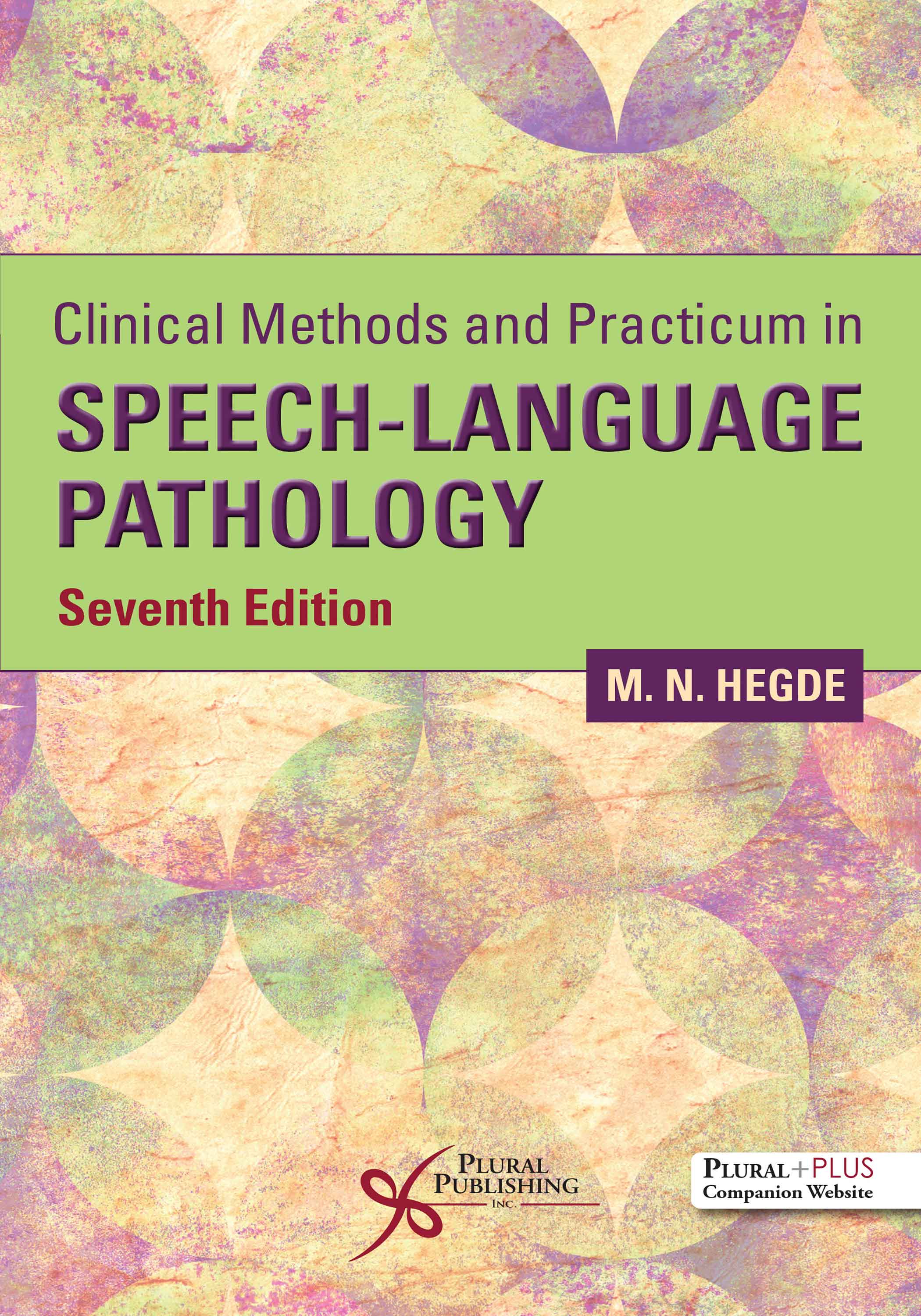
Clinical Methods and Practicum in Speech-Language Pathology
Seventh Edition
M.N. Hegde
Details: 413 pages, B&W, Softcover, 6" x 9"
ISBN13: 978-1-63550-691-4
© 2025 | Available
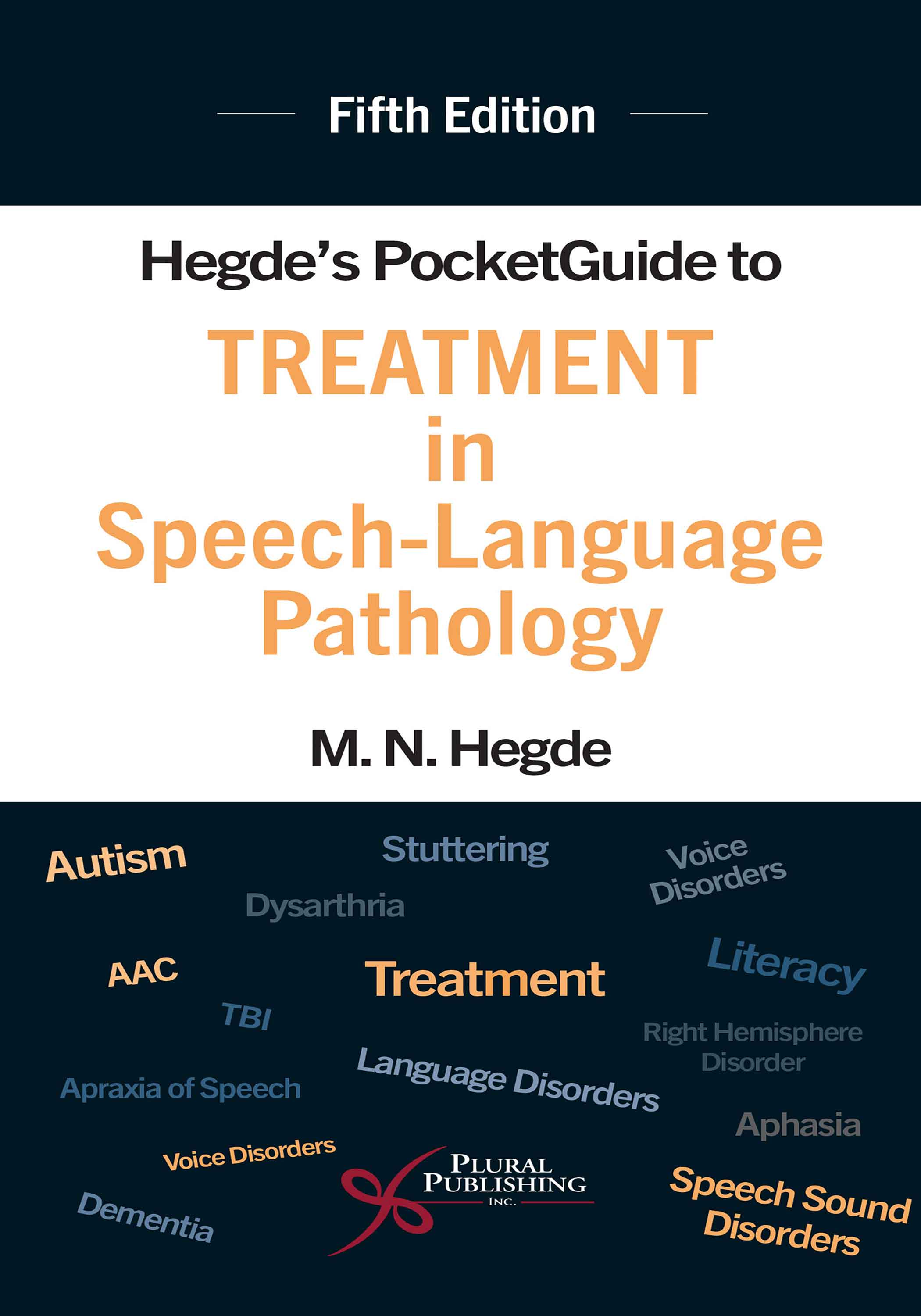
Hegde's PocketGuide to Treatment in Speech-Language Pathology
Fifth Edition
M.N. Hegde
Details: 475 pages, 2-Color, Softcover, 4.5" x 8"
ISBN13: 978-1-63550-786-7
© 2026 | Coming Soon
Release Date: 10/01/2025


